Interfacial Interaction in NiFe LDH/NiS2/VS2 for Enhanced Electrocatalytic Water Splitting
Abstract
1. Introduction
2. Results and Discussion
2.1. Characterization of Samples
2.2. Electrocatalytic Oxygen Evolution Reaction Performance
2.3. Electrocatalytic Hydrogen Evolution Reaction and Overall Water-Splitting Performance
3. Experimental Section
3.1. Materials
3.2. Pretreatment of Carbon Cloth (CC) Substrate
3.3. Preparation of 1:5 NiS2/VS2
3.4. Preparation of 350 s NiFe LDH/NiS2/VS2
3.5. Structural Characterization
3.6. Electrochemical Measurements
4. Conclusions
Supplementary Materials
Author Contributions
Funding
Institutional Review Board Statement
Informed Consent Statement
Data Availability Statement
Conflicts of Interest
References
- Xu, H.; Shang, H.; Wang, C.; Du, Y. Surface and interface engineering of noble-metal-free electrocatalysts for efficient overall water splitting. Coordin. Chem. Rev. 2020, 418, 213374. [Google Scholar] [CrossRef]
- Ahsan, M.; He, T.; Noveron, J.; Reuter, K.; Santiago, A.; Luque, R. Low-dimensional heterostructures for advanced electrocatalysis: An experimental and computational perspective. Chem. Soc. Rev. 2022, 51, 812–828. [Google Scholar] [CrossRef] [PubMed]
- Tang, J.; Xu, X.; Tang, T.; Zhong, Y.; Shao, Z. Perovskite-Based Electrocatalysts for Cost-Effective Ultrahigh-Current-Density Water Splitting in Anion Exchange Membrane Electrolyzer Cell. Small Methods 2022, 6, 2201099. [Google Scholar] [CrossRef]
- Abdelghafar, F.; Xu, X.; Jiang, S.P.; Shao, Z. Designing single-atom catalysts toward improved alkaline hydrogen evolution reaction. Mater. Rep. Energy 2022, 2, 100144. [Google Scholar] [CrossRef]
- Luo, Z.; Zhang, L.; Wu, L.; Wang, L.; Zhang, Q.; Ren, X.; Sun, X. Atomic-scale insights into the role of non-covalent interactions in electrocatalytic hydrogen evolution reaction. Nano Energy 2022, 102, 107654. [Google Scholar] [CrossRef]
- Yang, Y.; Liu, L.; Chen, S.; Yan, W.; Zhou, H.; Zhang, X.; Fan, X. Tuning Binding Strength of Multiple Intermediates towards Efficient pH-universal Electrocatalytic Hydrogen Evolution by Mo8O26-NbNxOy Heterocatalysts. Angew. Chem. Int. Ed. 2023, 62, e202306896. [Google Scholar] [CrossRef] [PubMed]
- Hou, Z.; Cui, C.; Li, Y.; Gao, Y.; Zhu, D.; Gu, Y.; Pan, G.; Zhu, Y.; Zhang, T. Lattice-Strain Engineering for Heterogenous Electrocatalytic Oxygen Evolution Reaction. Adv. Mater. 2023, 35, e2209876. [Google Scholar] [CrossRef]
- Li, C.; Zhao, J.; Xie, L.; Wu, J.; Ren, Q.; Wang, Y.; Li, G. Surface-Adsorbed Carboxylate Ligands on Layered Double Hydroxides/Metal–Organic Frameworks Promote the Electrocatalytic Oxygen Evolution Reaction. Angew. Chem. Int. Ed. 2021, 60, 18129–18137. [Google Scholar] [CrossRef]
- Jiao, S.; Fu, X.; Wang, S.; Zhao, Y. Perfecting electrocatalysts via imperfections: Towards the large-scale deployment of water electrolysis technology. Energy Environ. Sci. 2021, 14, 1722–1770. [Google Scholar] [CrossRef]
- Jiao, Y.-Q.; Yan, H.-J.; Tian, C.-G.; Fu, H.-G. Structure Engineering and Electronic Modulation of Transition Metal Interstitial Compounds for Electrocatalytic Water Splitting. Acc. Mater. Res. 2022, 4, 42–56. [Google Scholar] [CrossRef]
- He, X.; Han, X.; Zhou, X.; Chen, J.; Wang, J.; Chen, Y.; Yu, L.; Zhang, N.; Li, J.; Wang, S.; et al. Electronic modulation with Pt-incorporated NiFe layered double hydroxide for ultrastable overall water splitting at 1000 mA cm−2. Appl. Catal. B Environ. 2023, 331, 122683. [Google Scholar] [CrossRef]
- Zahran, Z.N.; Mohamed, E.A.; Tsubonouchi, Y.; Ishizaki, M.; Togashi, T.; Kurihara, M.; Saito, K.; Yui, T.; Yagi, M. Electrocatalytic water splitting with unprecedentedly low overpotentials by nickel sulfide nanowires stuffed into carbon nitride scabbards. Energy Environ. Sci. 2021, 14, 5358–5365. [Google Scholar] [CrossRef]
- Guo, Y.; Park, T.; Yi, J.W.; Henzie, J.; Kim, J.; Wang, Z.; Jiang, B.; Bando, Y.; Sugahara, Y.; Tang, J.; et al. Nanoarchitectonics for Transition-Metal-Sulfide-Based Electrocatalysts for Water Splitting. Adv. Mater. 2019, 31, 1807134. [Google Scholar] [CrossRef] [PubMed]
- Bhosale, M.; Thangarasu, S.; Murugan, N.; Kim, Y.; Oh, T. Engineering 2D heterostructured VS2-rGO-Ni nanointerface to timulate electrocatalytic water splitting and supercapacitor applications. J. Energy Storage 2023, 73, 109133. [Google Scholar] [CrossRef]
- He, W.; Zheng, X.; Peng, J.; Dong, H.; Wang, J.; Zhao, W. Mo-dopant-strengthened basal-plane activity in VS2 for accelerating hydrogen evolution reaction. Chem. Eng. J. 2020, 396, 125227. [Google Scholar] [CrossRef]
- Wu, Y.; Liu, X.; Han, D.; Song, X.; Shi, L.; Song, Y.; Niu, S.; Xie, Y.; Cai, J.; Wu, S.; et al. Electron density modulation of NiCo2S4 nanowires by nitrogen incorporation for highly efficient hydrogen evolution catalysis. Nat. Commun. 2018, 9, 1425. [Google Scholar] [CrossRef]
- Zhang, L.; Rong, J.; Lin, Y.; Yang, Y.; Zhu, H.; Yu, X.; Kang, X.; Chen, C.; Cheng, H.; Liu, G. Mesoporous Single Crystal NiS2 Microparticles with FeS Clusters Decorated on the Pore Walls for Efficient Electrocatalytic Oxygen Evolution. Adv. Funct. Mater. 2023, 33, 2307947. [Google Scholar] [CrossRef]
- Cheng, Y.; Fu, P.; Yang, X.; Zhang, Y.; Jin, S.; Liu, H.; Shen, Y.; Guo, X.; Chen, L. MoP4/Ni3S2/MoO3 heterogeneous structure nanorod arrays for efficient solar-enhanced overall water splitting. J. Mater. Chem. A 2023, 11, 24764–24776. [Google Scholar] [CrossRef]
- Hou, Z.; Cui, C.; Yang, Y.; Zhang, T. Electrochemical Oxidation Encapsulated Ru Clusters Enable Robust Durability for Efficient Oxygen Evolution. Small 2023, 19, 2207170. [Google Scholar] [CrossRef]
- Pei, C.; Kim, M.; Li, Y.; Xia, C.; Kim, J.; So, W.; Yu, X.; Park, H.; Kim, J. Electron Transfer-Induced Metal Spin-Crossover at NiCo2S4/ReS2 2D-2D Interfaces for Promoting pH-universal Hydrogen Evolution Reaction. Adv. Funct. Mater. 2022, 33, 2210072. [Google Scholar] [CrossRef]
- Yu, J.; Qian, Y.; Seo, S.; Liu, Y.; Bui, H.T.; Tran, N.Q.; Lee, J.; Kumar, A.; Wang, H.; Luo, Y.; et al. Exploring catalytic behaviors of CoS2-ReS2 heterojunction by interfacial engineering. J. Energy Chem. 2023, 85, 11–18. [Google Scholar] [CrossRef]
- Xu, X.; Pan, Y.; Ge, L.; Chen, Y.; Mao, X.; Guan, D.; Li, M.; Zhong, Y.; Hu, Z.; Peterson, V.K.; et al. High-Performance Perovskite Composite Electrocatalysts Enabled by Controllable Interface Engineering. Small 2021, 17, 2101573. [Google Scholar] [CrossRef]
- Gu, B.S.; Dutta, S.; Hong, Y.; Okello, O.F.N.; Im, H.; Ahn, S.; Choi, S.; Han, J.W.; Ryu, S.; Lee, I.S. Harmonious Heterointerfaces Formed on 2D-Pt Nanodendrites by Facet-Respective Stepwise Metal Deposition for Enhanced Hydrogen Evolution Reaction. Angew. Chem. Int. Ed. 2023, 62, e202307816. [Google Scholar] [CrossRef]
- Liu, X.; Wang, P.; Liang, X.; Zhang, Q.; Wang, Z.; Liu, Y.; Zheng, Z.; Dai, Y.; Huang, B. Research progress and surface/interfacial regulation methods for electrophotocatalytic hydrogen production from water splitting. Mater. Today Energy 2020, 18, 100524. [Google Scholar] [CrossRef]
- Feng, X.; Jiao, Q.; Chen, W.; Dang, Y.; Dai, Z.; Suib, S.L.; Zhang, J.; Zhao, Y.; Li, H.; Feng, C. Cactus-like NiCo2S4@NiFe LDH hollow spheres as an effective oxygen bifunctional electrocatalyst in alkaline solution. Appl. Catal. B Environ. 2021, 286, 119869. [Google Scholar] [CrossRef]
- Cao, D.; Shao, J.; Cui, Y.; Zhang, L.; Cheng, D. Interfacial Engineering of Copper-Nickel Selenide Nanodendrites for Enhanced Overall Water Splitting in Alkali Condition. Small 2023, 19, 2301613. [Google Scholar] [CrossRef] [PubMed]
- Yu, L.; Zhou, H.; Sun, J.; Mishra, I.; Luo, D.; Yu, F.; Yu, Y.; Chen, S.; Ren, Z. Amorphous NiFe layered double hydroxide nanosheets decorated on 3D nickel phosphide nanoarrays: A hierarchical core-shell electrocatalyst for efficient oxygen evolution. J. Mater. Chem. A 2018, 6, 13619–13623. [Google Scholar] [CrossRef]
- Zhao, Y.; Zhang, X.; Jia, X.; Waterhouse, G.; Shi, R.; Zhang, X.; Zhan, F.; Tao, Y.; Wu, L.; Tung, C.; et al. Sub-3 nm ultrafine monolayer layered double hydroxide nanosheets for electrochemical water oxidation. Adv. Energy Mater. 2018, 8, 1703585. [Google Scholar] [CrossRef]
- Zhai, Y.; Ren, X.; Sun, Y.; Li, D.; Wang, B.; Liu, S. Synergistic effect of multiple vacancies to induce lattice oxygen redox in NiFe-layered double hydroxide OER catalysts. Appl. Catal. B Environ. 2023, 323, 122091. [Google Scholar] [CrossRef]
- Du, Y.; Liu, D.; Li, T.; Yan, Y.; Liang, Y.; Yan, S.; Zou, Z. A phase transformation-free redox couple mediated electrocatalytic oxygen evolution reaction. Appl. Catal. B Environ. 2022, 306, 121146. [Google Scholar] [CrossRef]
- Feng, X.; Jiao, Q.; Dai, Z.; Dang, Y.; Suib, S.L.; Zhang, J.; Zhao, Y.; Li, H.; Feng, C.; Li, A. Revealing the effect of interfacial electron transfer in heterostructured Co9S8@NiFe LDH for enhanced electrocatalytic oxygen evolution. J. Mater. Chem. A 2021, 9, 12244. [Google Scholar] [CrossRef]
- Wu, S.-W.; Liu, S.-Q.; Tan, X.-H.; Zhang, W.-Y.; Cadien, K.; Li, Z. Ni3S2-embedded NiFe LDH porous nanosheets with abundant heterointerfaces for high-current water electrolysis. Chem. Eng. J. 2022, 442, 136105. [Google Scholar] [CrossRef]
- Jia, L.; Du, G.; Han, D.; Hao, Y.; Zhao, W.; Fan, Y.; Su, Q.; Ding, S.; Xu, B. Ni3S2/Cu-NiCo LDH heterostructure nanosheet arrays on Ni foam for electrocatalytic overall water splitting. J. Mater. Chem. A 2021, 9, 27639–27650. [Google Scholar] [CrossRef]
- Li, J.; Liu, X.; Zhao, H.; Zhang, Q.; Du, B.; Lu, L.; Liu, N.; Yang, Y.; Zhao, N.; Pang, X.; et al. Hybrid Nano-Phase Ion/Electron Dual Pathways of Nickel/Cobalt–Boride Cathodes Boosting Intercalation Kinetics for Alkaline Batteries. ACS Appl. Mater. Interfaces 2023, 15, 2843–2851. [Google Scholar] [CrossRef] [PubMed]
- Shit, S.; Bolar, S.; Murmu, N.C.; Kuila, T. Tailoring the bifunctional electrocatalytic activity of electrodeposited molybdenum sulfide/iron oxide heterostructure to achieve excellent overall water splitting. Chem. Eng. J. 2021, 417, 1293333. [Google Scholar] [CrossRef]
- Wang, T.; Liu, X.; Yan, Z.; Teng, Y.; Li, R.; Zhang, J.; Peng, T. Facile Preparation Process of NiCoP-NiCoSe2 Nano-Bilayer Films for Oxygen Evolution Reaction with High Efficiency and Long Duration. ACS Sustain. Chem. Eng. 2020, 8, 1240–1251. [Google Scholar] [CrossRef]
- Zhu, J.; Cai, L.; Yin, X.; Wang, Z.; Zhang, L.; Ma, H.; Ke, Y.; Du, Y.; Xi, S.; Wee, A.T.S.; et al. Enhanced Electrocatalytic Hydrogen Evolution Activity in Single-Atom Pt-Decorated VS2 Nanosheets. ACS Nano 2020, 14, 5600–5608. [Google Scholar] [CrossRef] [PubMed]
- Singh, V.K.; Nakate, U.T.; Bhuyan, P.; Chen, J.; Tran, D.T.; Park, S. Mo/Co doped 1T-VS2 nanostructures as a superior bifunctional electrocatalyst for overall water splitting in alkaline media. J. Mater. Chem. A 2022, 10, 9067–9079. [Google Scholar] [CrossRef]
- Xu, D.; Ke, J.; Liu, H.; Bi, Y.; Liu, J. In situ construction of Ni-based N doped porous carbon induced by sulfurization or phosphorization for synergistically enhanced photo/electrocatalytic hydrogen evolution. J. Mater. Sci. Technol. 2023, 179, 66–78. [Google Scholar] [CrossRef]
- Wang, H.; Liang, M.; Miao, Z. Engineering accordion-like Fe-doped NiS2 enabling high-performance aqueous supercapacitors and Zn-Ni batteries. Chem. Eng. J. 2023, 470, 144148. [Google Scholar] [CrossRef]
- Tong, L.; Song, C.; Liu, Y.; Xing, R.; Sekar, K.; Liu, S. Open and porous NiS2 nanowrinkles grown on non-stoichiometric MoOx nanorods for high-performance alkaline water electrolysis and supercapacitor. Int. J. Hydrogen Energy 2022, 47, 14404–14413. [Google Scholar] [CrossRef]
- Yang, Z.; Lin, Y.; Jiao, F.; Li, J.; Wang, J.; Gong, Y. In situ growth of 3D walnut-like nano-architecture Mo-Ni2P@NiFe LDH/NF arrays for synergistically enhanced overall water splitting. J. Energy Chem. 2020, 49, 189–197. [Google Scholar] [CrossRef]
- Li, X.; Zheng, L.; Liu, S.; Ouyang, T.; Ye, S.; Liu, Z. Heterostructures of NiFe LDH hierarchically assembled on MoS2 nanosheets as high-efficiency electrocatalysts for overall water splitting. Chin. Chem. Lett. 2022, 33, 4761–4765. [Google Scholar] [CrossRef]
- Qu, Y.; Shao, M.; Shao, Y.; Yang, M.; Xu, J.; Kwok, C.T.; Shi, X.; Lu, Z.; Pan, H. Ultra-high electrocatalytic activity of VS2 nanoflowers for efficient hydrogen evolution reaction. J. Mater. Chem. A 2017, 5, 15080–15086. [Google Scholar] [CrossRef]
- Chen, X.; Cheng, N.; Ding, Y.-L.; Liu, Z. NiS2 microsphere/carbon nanotubes hybrids with reinforced concrete structure for potassium ion storage. J. Electroanal. Chem. 2021, 904, 115852. [Google Scholar] [CrossRef]
- Zheng, Y.; Deng, H.; Feng, H.; Luo, G.; Tu, R.; Zhang, L. Triethanolamine-assisted synthesis of NiFe layered double hydroxide ultrathin nanosheets for efficient oxygen evolution reaction. J. Colloid Interface Sci. 2023, 629, 610–619. [Google Scholar] [CrossRef] [PubMed]
- Wang, S.; Xiong, D.; Chen, C.; Gu, M.; Yi, F. The controlled fabrication of hierarchical CoS2@NiS2 core-shell nanocubes by utilizing prussian blue analogue for enhanced capacitive energy storage performance. J. Power Sources 2020, 450, 227712. [Google Scholar] [CrossRef]
- Zhang, J.; Zhang, H.; Huang, Y. Electron-rich NiFe layered double hydroxides via interface engineering for boosting electrocatalytic oxygen evolution. Appl. Catal. B Environ. 2021, 297, 120453. [Google Scholar] [CrossRef]
- Wu, S.; Wang, W.; Shan, J.; Wang, X.; Lu, D.; Zhu, J.; Liu, Z.; Yue, L.; Li, Y. Conductive 1T-VS2-MXene heterostructured bidirectional electrocatalyst enabling compact Li-S batteries with high volumetric and areal capacity. Energy Storage Mater. 2022, 49, 153–163. [Google Scholar] [CrossRef]
- Hussain, S.; Vikraman, D.; Sarfraz, M.; Faizan, M.; Patil, S.; Batoo, K.; Nam, K.; Kim, H.; Jung, J. Design of XS2 (X = W or Mo)-Decorated VS2 Hybrid Nano-Architectures with Abundant Active Edge Sites for High-Rate Asymmetric Supercapacitors and Hydrogen Evolution Reactions. Small 2022, 19, 2205881. [Google Scholar] [CrossRef]
- Feng, T.; Ouyang, C.; Zhan, Z.; Lei, T.; Yin, P. Cobalt doping VS2 on nickel foam as a high efficient electrocatalyst for hydrogen evolution reaction. Int. J. Hydrogen Energy 2022, 47, 10646–10653. [Google Scholar] [CrossRef]
- Yu, S.H.; Tang, Z.; Shao, Y.; Dai, H.; Wang, H.Y.; Yan, J.; Pan, H.; Chua, D.H.C. In Situ Hybridizing MoS2 Microflowers on VS2 Microflakes in a One-Pot CVD Process for Electrolytic Hydrogen Evolution Reaction. ACS Appl. Energy Mater. 2019, 2, 5799–5808. [Google Scholar] [CrossRef]
- Zhou, W.; Li, X.; Li, X.; Shao, J.; Yang, H.; Chai, X.; Hu, Q.; He, C. Crafting amorphous VO2–crystalline NiS2 heterostructures as bifunctional electrocatalysts for efficient water splitting: The different cocatalytic function of VO2. Chem. Eng. J. 2023, 470, 144146. [Google Scholar] [CrossRef]
- Zhang, K.; Jia, J.; Tan, L.; Qi, S.; Li, B.; Chen, J.; Li, J.; Lou, Y.; Guo, Y. Morphological and electronic modification of NiS2 for efficient supercapacitors and hydrogen evolution reaction. J. Power Sources 2023, 577, 233239. [Google Scholar] [CrossRef]
- Jiang, K.; Li, Q.; Lei, S.; Zhai, M.; Cheng, M.; Xu, L.; Deng, Y.; Xu, H.; Bao, J. Nb-doped NiFe LDH nanosheet with superhydrophilicity and superaerophobicity surface for solar cell-driven electrocatalytic water splitting. Electrochim. Acta 2022, 429, 140947. [Google Scholar] [CrossRef]
- Li, Y.; Xu, H.; Yang, P.; Li, R.; Wang, D.; Ren, P.; Ji, S.; Lu, X.; Meng, F.; Zhang, J.; et al. Interfacial engineering induced highly efficient CoNiP@NiFe layered double hydroxides bifunctional electrocatalyst for water splitting. Mater. Today Energy 2022, 25, 100975. [Google Scholar] [CrossRef]
- Zhou, Y.; Guo, Q.; Luo, J.; Wang, X.; Sun, F.; Wang, C.; Wang, S.; Zhang, J. The influence of increased content of Ni(III) in NiFe LDH via Zn doping on electrochemical catalytic oxygen evolution reaction. Int. J. Hydrogen Energy 2023, 48, 4984–4993. [Google Scholar] [CrossRef]
- Liu, X.; Zhao, X.; Cao, S.; Xu, M.; Wang, Y.; Xue, W.; Li, J. Local hydroxyl enhancement design of NiFe sulfide electrocatalyst toward efficient oxygen evolution reaction. Appl. Catal. B Environ. 2023, 331, 122715. [Google Scholar] [CrossRef]
- Geng, S.; Sheng, J.; Yang, W.; Tian, F.; Li, M.; Yu, Y.; Liu, Y.; Hou, Y. Activating interfacial S sites of MoS2 boosts hydrogen evolution electrocatalysis. Nano Res. 2021, 15, 1809–1816. [Google Scholar] [CrossRef]
- Zhou, S.; Wang, J.; Li, J.; Fan, L.; Liu, Z.; Shi, J.; Cai, W. Surface-growing organophosphorus layer on layered double hydroxides enables boosted and durable electrochemical freshwater/seawater oxidation. Appl. Catal. B Environ. 2023, 332, 122749. [Google Scholar] [CrossRef]
- Jiang, Q.; Wang, S.; Zhang, C.; Sheng, Z.; Zhang, H.; Feng, R.; Ni, Y.; Tang, X.; Gu, Y.; Zhou, X.; et al. Active oxygen species mediate the iron-promoting electrocatalysis of oxygen evolution reaction on metal oxyhydroxides. Nat. Commun. 2023, 14, 6826. [Google Scholar] [CrossRef]
- Bolar, S.; Samanta, P.; Jang, W.; Yang, C.M.; Murmu, N.C.; Kuila, T. Regulating the Metal Concentration for Selective Tuning of VS2/MoS2 Heterostructures toward Hydrogen Evolution Reaction in Acidic and Alkaline Media. ACS Appl. Energy Mater. 2022, 5, 10086–10097. [Google Scholar] [CrossRef]
- Patil, S.A.; Rabani, I.; Hussain, S.; Seo, Y.S.; Jung, J.; Shrestha, N.K.; Im, H.; Kim, H. A Facile Design of Solution-Phase Based VS2 Multifunctional Electrode for Green Energy Harvesting and Storage. Nanomaterials 2022, 12, 339. [Google Scholar] [CrossRef] [PubMed]
- Patil, S.A.; Shrestha, N.K.; Bui, H.T.; Chavan, V.D.; Kim, D.-K.; Shaikh, S.F.; Ubaidullah, M.; Kim, H.; Im, H. Solvent modulated self-assembled VS2 layered microstructure for electrocatalytic water and urea decomposition. Int. J. Energy Res. 2022, 46, 8413–8423. [Google Scholar] [CrossRef]
- Dhakal, P.P.; Pan, U.N.; Paudel, D.R.; Kandel, M.R.; Kim, N.H.; Lee, J.H. Cobalt-manganese sulfide hybridized Fe-doped 1T-Vanadium disulfide 3D-Hierarchical core-shell nanorods for extreme low potential overall water-splitting. Mater. Today Nano 2022, 20, 100272. [Google Scholar] [CrossRef]
- Sekar, K.; Raji, G.; Chen, S.; Liu, S.H.; Xing, R.M. Ultrathin VS2 nanosheets vertically aligned on NiCo2S4@C3N4 hybrid for asymmetric supercapacitor and alkaline hydrogen evolution reaction. Appl. Surf. Sci. 2020, 527, 146856. [Google Scholar] [CrossRef]
- Ghorui, U.K.; Mondal, P.; Adhikary, B.; Mondal, A.; Sarkar, A. Newly Designed One-Pot In-Situ Synthesis of VS2/rGO Nanocomposite to Explore Its Electrochemical Behavior towards Oxygen Electrode Reactions. ChemElectroChem 2022, 9, e202200526. [Google Scholar] [CrossRef]
- Zhang, L.L.; Yang, Y.Q.; Zhu, H.Z.; Cheng, H.M.; Liu, G. Iron-doped NiS2 microcrystals with exposed {0 0 1} facets for electrocatalytic water oxidation. J. Colloid. Interf. Sci. 2022, 608, 599–604. [Google Scholar] [CrossRef]
- Wen, F.S.; Pang, L.; Zhang, T.; Huang, X.L.; Xu, Y.; Li, Y.L. Fe doped NiS2 derived from metal-organic framework embedded into g-C3N4 for efficiently oxygen evolution reaction. Int. J. Hydrogen Energy 2023, 48, 33525–33536. [Google Scholar] [CrossRef]
- Zhang, X.Y.; Qiu, Y.L.; Li, Q.; Liu, F.G.; Cui, L.; Li, C.M.; Liu, J.Q. Sandwich structured Fe3O4/NiFe LDH/Fe3O4 as a bifunctional electrocatalyst with superior stability for highly sustained overall water splitting. J. Alloys Compd. 2023, 932, 167612. [Google Scholar] [CrossRef]
- Wang, J.; Lv, G.; Wang, C. A highly efficient and robust hybrid structure of CoNiN@NiFe LDH for overall water splitting by accelerating hydrogen evolution kinetics on NiFe LDH. Appl. Surf. Sci. 2021, 570, 151182. [Google Scholar] [CrossRef]
- Li, Y.T.; Dai, T.Y.; Wu, Q.X.; Lang, X.Y.; Zhao, L.J.; Jiang, Q. Design heterostructure of NiS-NiS2 on NiFe layered double hydroxide with Mo doping for efficient overall water splitting. Mater. Today Energy 2022, 23, 100906. [Google Scholar] [CrossRef]
- Zhang, X.; Fan, J.J.; Lu, X.Y.; Han, Z.J.; Cazorla, C.; Hu, L.; Wu, T.; Chu, D. Bridging NiCo layered double hydroxides and Ni3S2 for bifunctional electrocatalysts: The role of vertical graphene. Chem. Eng. J. 2021, 415, 129048. [Google Scholar] [CrossRef]
- Lee, Y.J.; Park, S.K. Metal-Organic Framework-Derived Hollow CoSx Nanoarray Coupled with NiFe Layered Double Hydroxides as Efficient Bifunctional Electrocatalyst for Overall Water Splitting. Small 2022, 18, 2200586. [Google Scholar] [CrossRef]
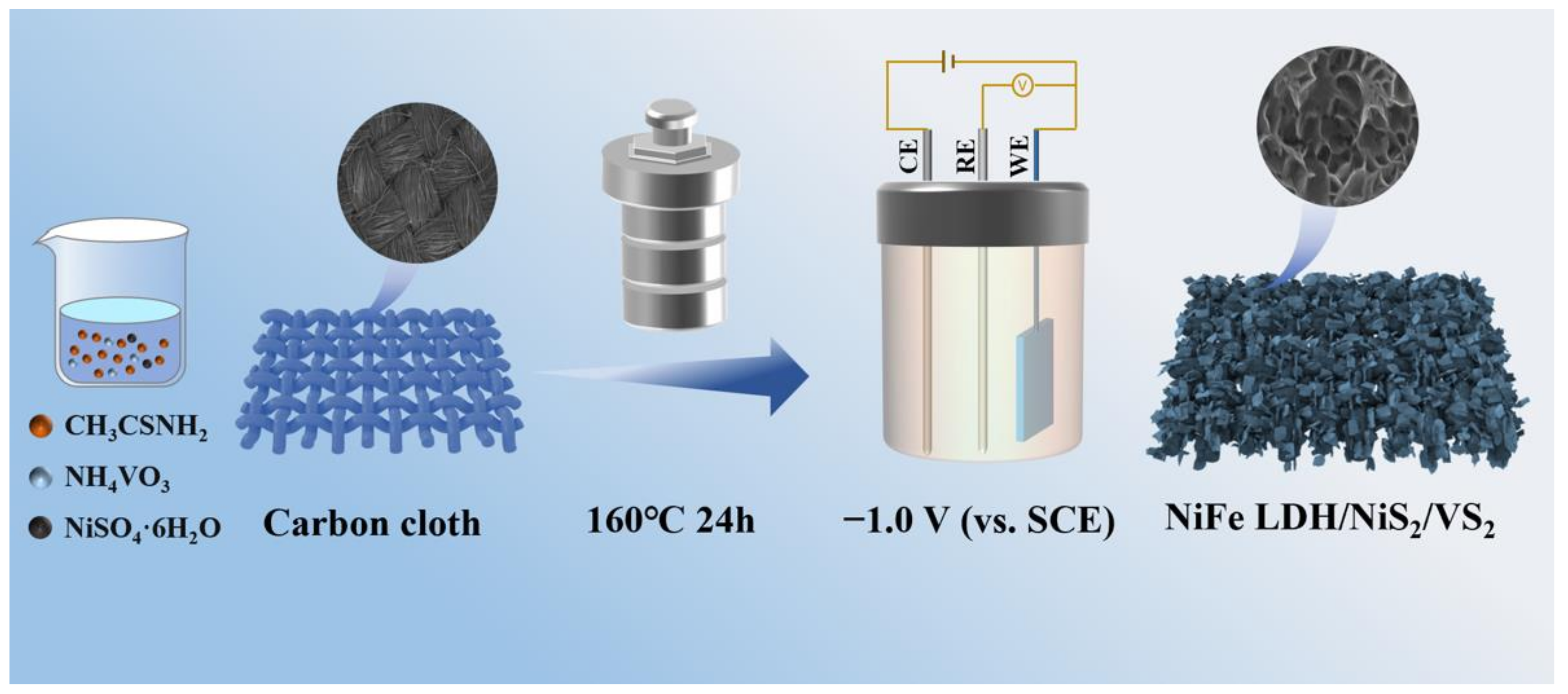
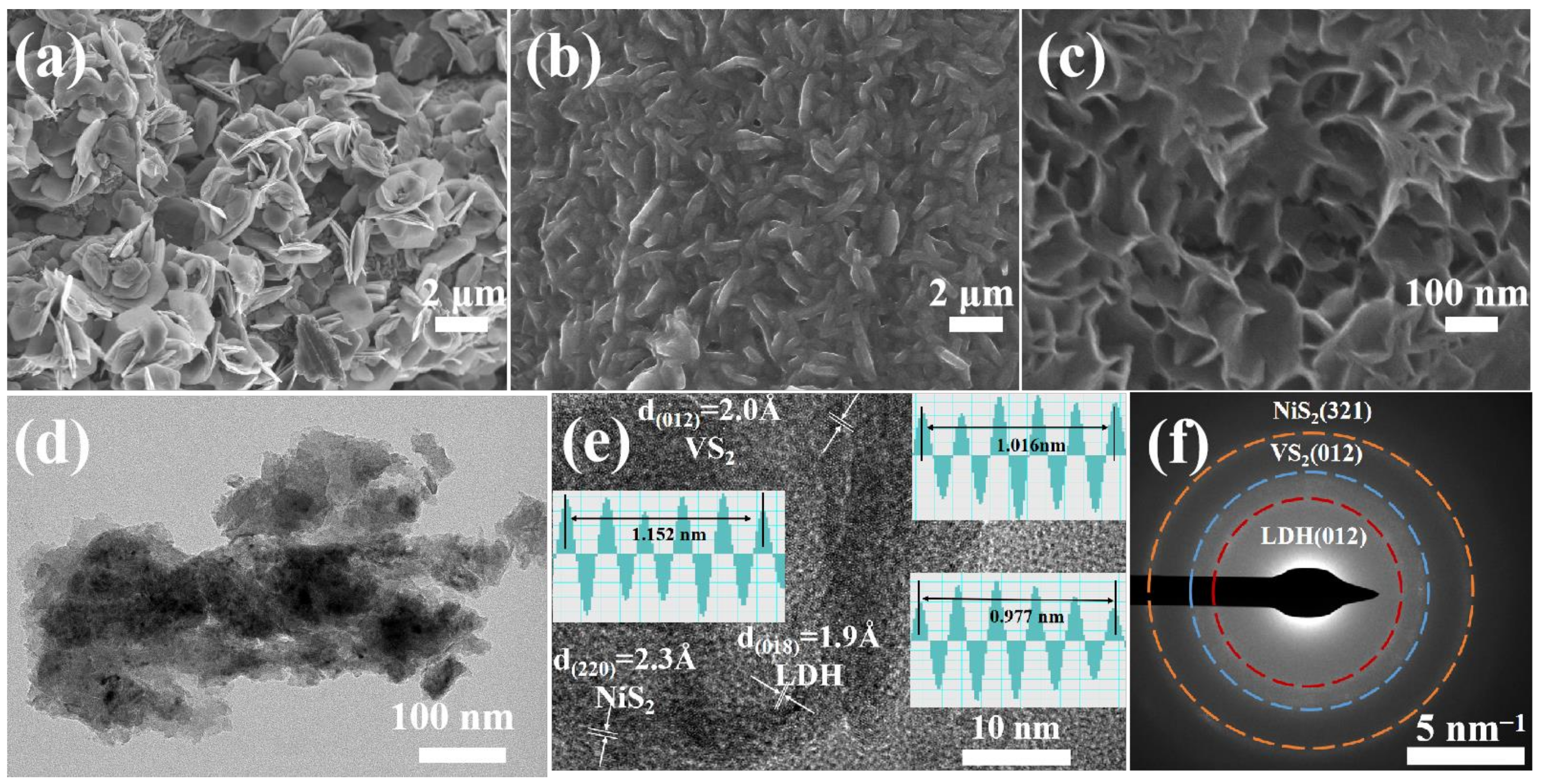
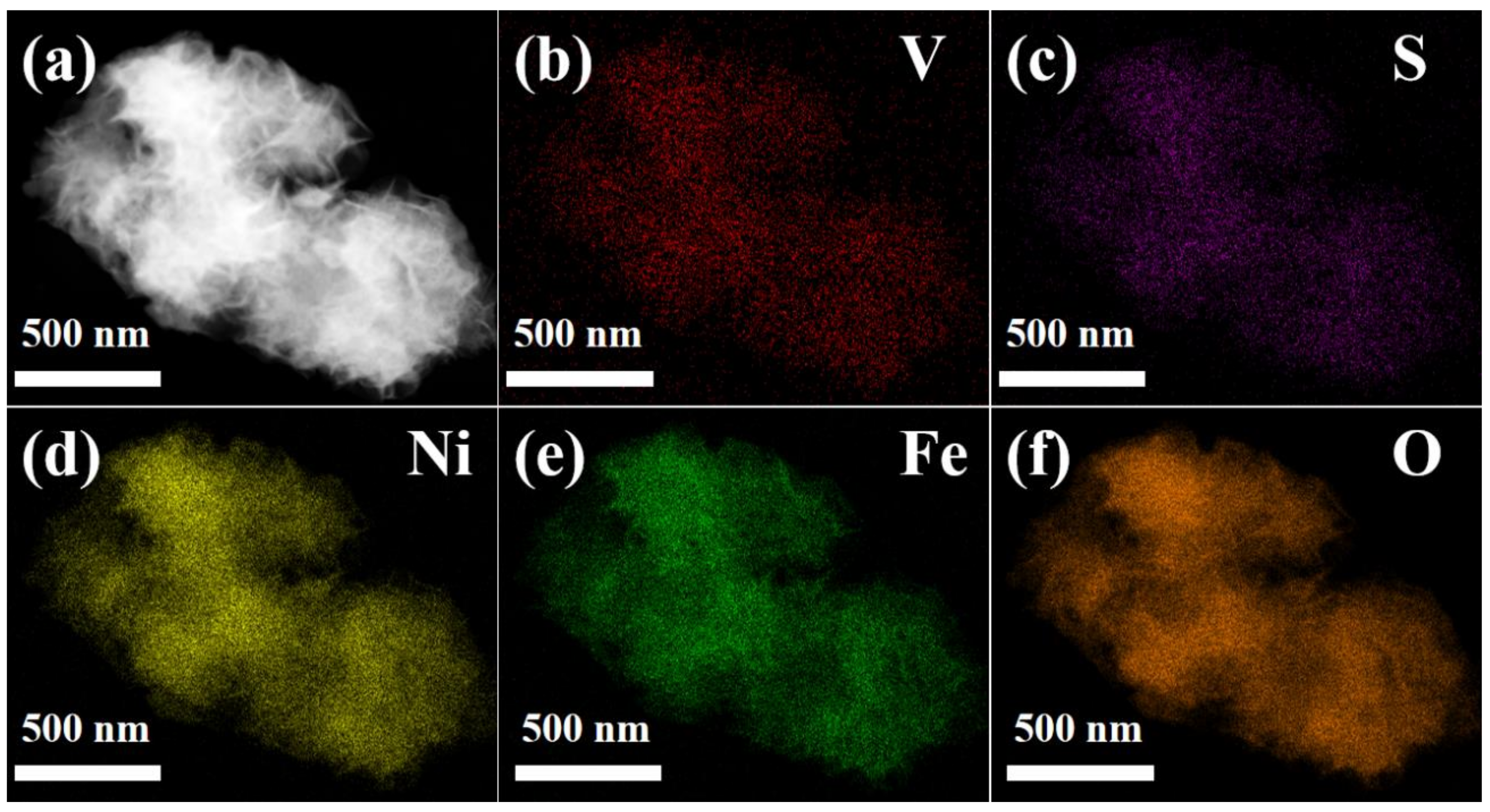
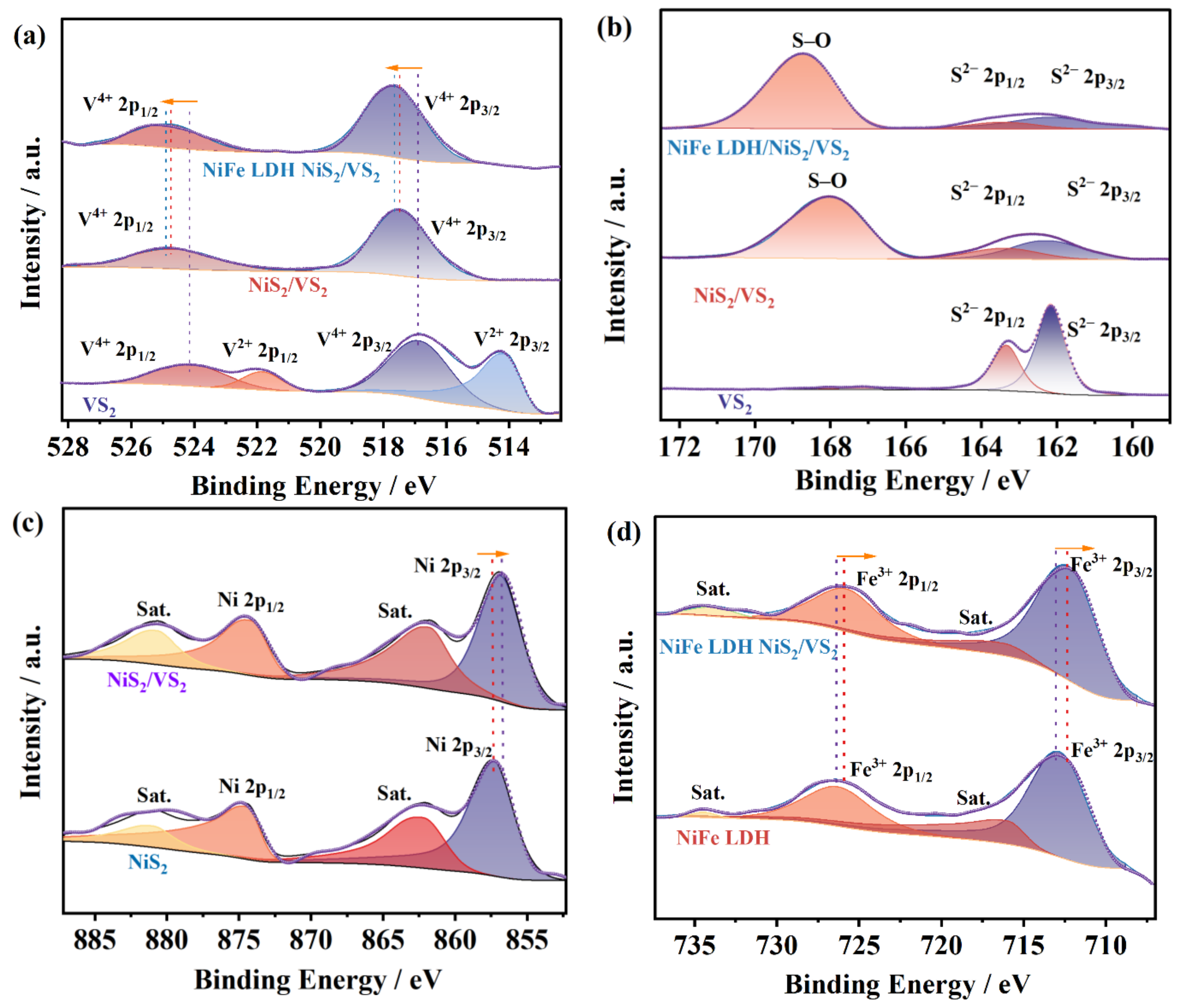

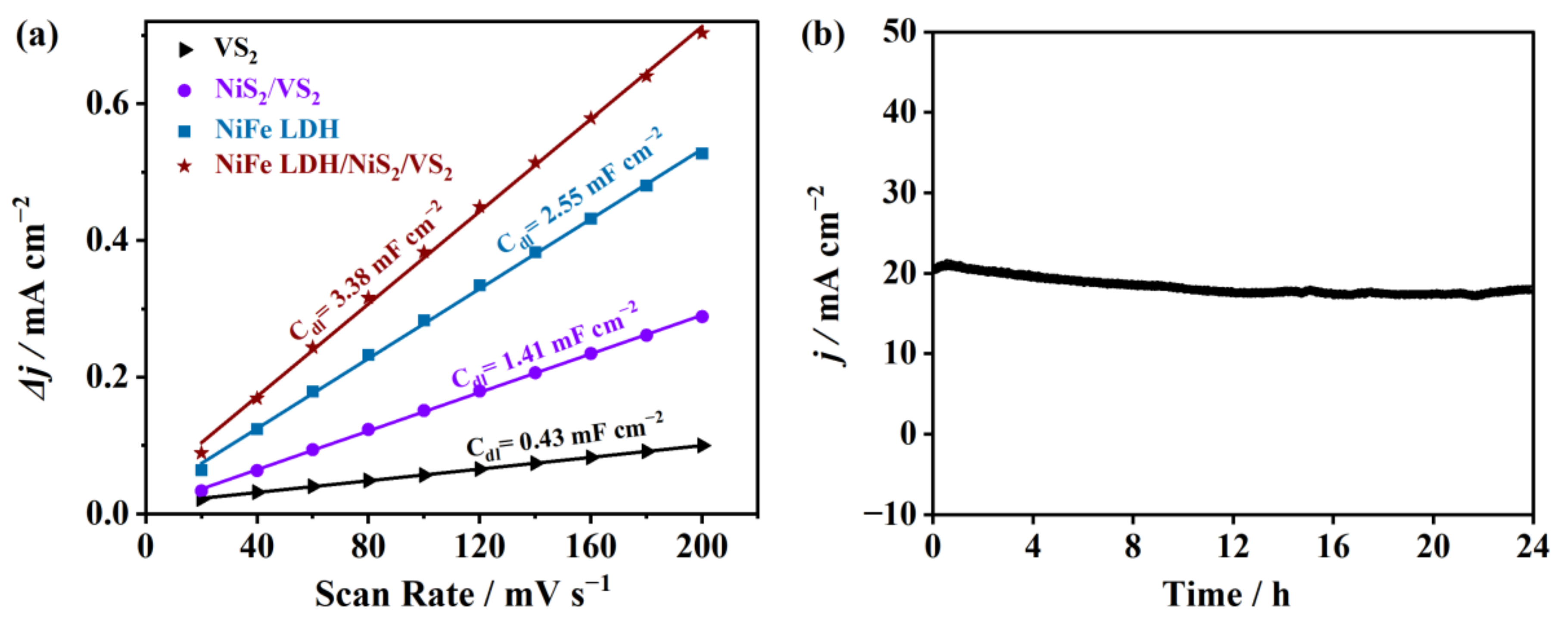
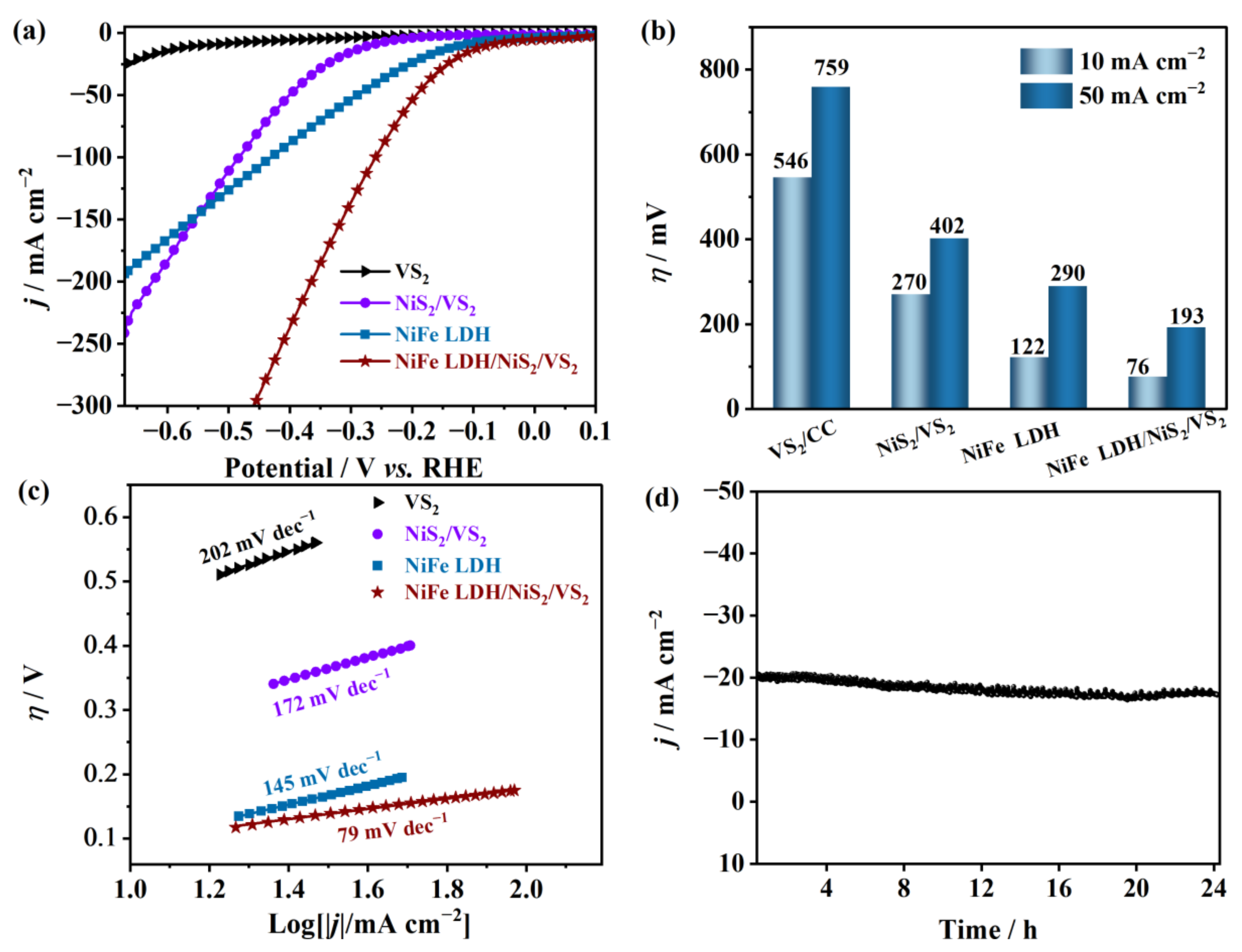
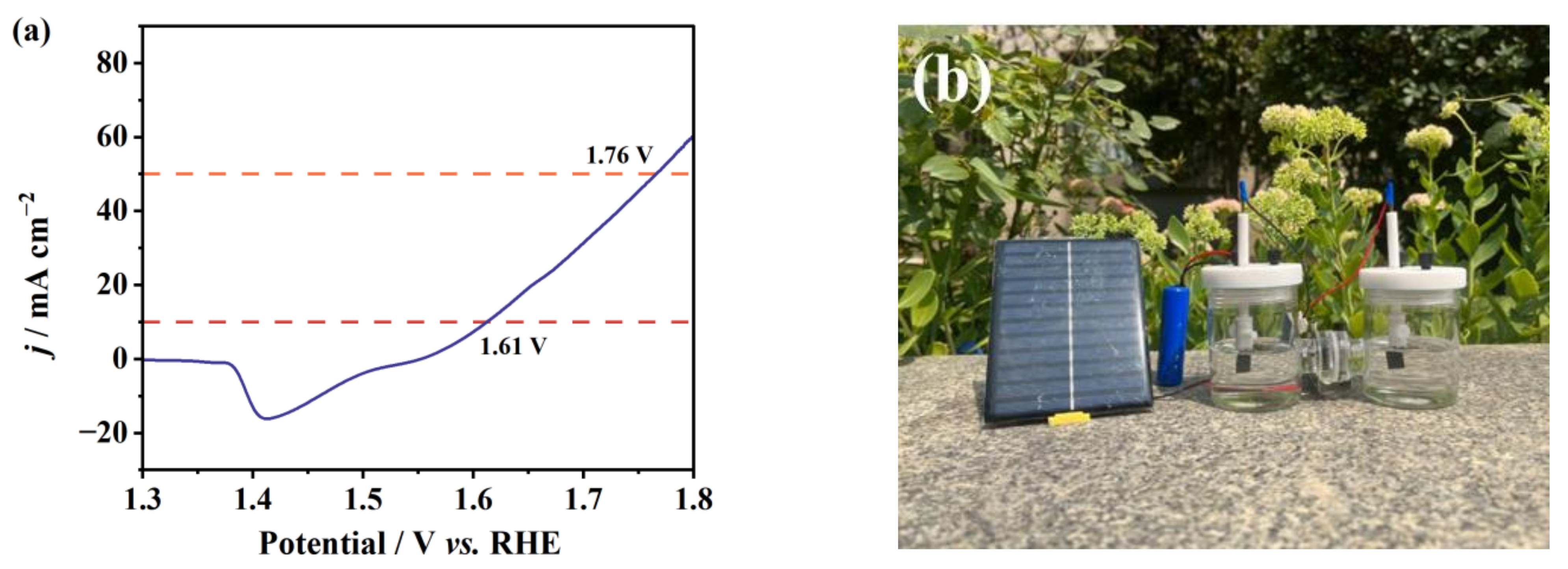
Disclaimer/Publisher’s Note: The statements, opinions and data contained in all publications are solely those of the individual author(s) and contributor(s) and not of MDPI and/or the editor(s). MDPI and/or the editor(s) disclaim responsibility for any injury to people or property resulting from any ideas, methods, instructions or products referred to in the content. |
© 2024 by the authors. Licensee MDPI, Basel, Switzerland. This article is an open access article distributed under the terms and conditions of the Creative Commons Attribution (CC BY) license (https://creativecommons.org/licenses/by/4.0/).
Share and Cite
Wang, T.; Zhang, X.; Yu, X.; Li, J.; Wang, K.; Niu, J. Interfacial Interaction in NiFe LDH/NiS2/VS2 for Enhanced Electrocatalytic Water Splitting. Molecules 2024, 29, 951. https://doi.org/10.3390/molecules29050951
Wang T, Zhang X, Yu X, Li J, Wang K, Niu J. Interfacial Interaction in NiFe LDH/NiS2/VS2 for Enhanced Electrocatalytic Water Splitting. Molecules. 2024; 29(5):951. https://doi.org/10.3390/molecules29050951
Chicago/Turabian StyleWang, Tingxia, Xu Zhang, Xiaojiao Yu, Junpeng Li, Kai Wang, and Jinfen Niu. 2024. "Interfacial Interaction in NiFe LDH/NiS2/VS2 for Enhanced Electrocatalytic Water Splitting" Molecules 29, no. 5: 951. https://doi.org/10.3390/molecules29050951
APA StyleWang, T., Zhang, X., Yu, X., Li, J., Wang, K., & Niu, J. (2024). Interfacial Interaction in NiFe LDH/NiS2/VS2 for Enhanced Electrocatalytic Water Splitting. Molecules, 29(5), 951. https://doi.org/10.3390/molecules29050951





